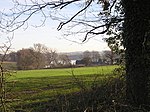Charnwood Lodge

Charnwood Lodge is a 134.2-hectare (332-acre) biological and geological Site of Special Scientific Interest in Charnwood Forest, east of Coalville in Leicestershire. It is a national nature reserve, and contains two Geological Conservation Review sites. It is managed by the Leicestershire and Rutland Wildlife Trust.This is the largest area of moorland in the East Midlands, and it is mainly covered by bracken on dry hills, while wet heath is dominated by purple moor-grass. The site is geologically important for the 'bomb' rocks, volcanic blocks dating the Ediacaran period around 600 million years ago.Part of the site is open to the public, with access from Warren Hills Road.
Excerpt from the Wikipedia article Charnwood Lodge (License: CC BY-SA 3.0, Authors, Images).Charnwood Lodge
Warren Hills Road, North West Leicestershire
Geographical coordinates (GPS) Address Website Nearby Places Show on map
Geographical coordinates (GPS)
| Latitude | Longitude |
|---|---|
| N 52.733 ° | E -1.312 ° |
Address
Charnwood Lodge National Nature Reserve
Warren Hills Road
LE67 4UX North West Leicestershire
England, United Kingdom
Open on Google Maps










